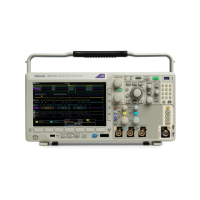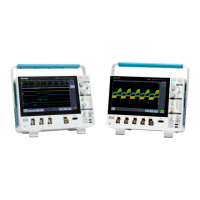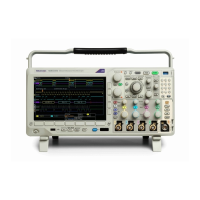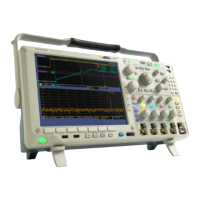Do you have a question about the Tektronix MDO3024 and is the answer not in the manual?
| Analog Channels | 4 |
|---|---|
| Bandwidth | 200 MHz |
| Sample Rate | 2.5 GS/s |
| Record Length | 10 Mpoints |
| Digital Channels | 16 (optional) |
| Spectrum Analyzer Frequency Range | 9 kHz to 3 GHz |
| Digital Voltmeter | 4-digit |
| Vertical Resolution | 8 bits |
| Operating Temperature | 0 °C to +50 °C |
| Display | 9-inch WVGA (800x480) color display |
| Connectivity | USB, LAN, GPIB (optional) |
| Arbitrary Function Generator | 50 MHz |
| Trigger Modes | Edge, Pulse Width, Logic, Video, Runt, Rise/Fall Time, Setup/Hold |
| Input Impedance | 1 MΩ ±1% |
| Max Input Voltage | 300 VRMS |
| Trigger Types | Edge, Pulse Width, Logic, Video, Runt, Rise/Fall Time, Setup/Hold |
Key safety precautions for product operation and preventing injury or damage.
Guidelines to prevent fire and personal injury hazards during operation.
Instructions on preventing contact with exposed circuitry when power is present.
Safety considerations and instructions for connecting and using probes and test leads.
Additional information for safely performing service procedures on the product.
Procedures and information for connecting various types of probes to the oscilloscope.
Step-by-step instructions for powering on the oscilloscope and proper grounding.
Instructions for downloading and installing the latest firmware for the oscilloscope.
Methods for connecting the oscilloscope to a computer for data analysis and control.
How to access and control the oscilloscope remotely via a web browser using LXI and e*Scope.
Overview of the oscilloscope's front panel layout, including buttons, controls, and connectors.
Detailed explanation of how to use the front panel menu system and controls.
Step-by-step guide on navigating and interacting with the oscilloscope's menu system.
Explanation of the functions of various menu buttons on the front panel.
Description of various elements and readouts displayed on the time domain waveform screen.
Identification and description of connectors located on the rear panel of the oscilloscope.
Procedures for setting up analog channels to acquire signals using front panel controls.
How to use the Autoset function to automatically configure the oscilloscope for optimal display.
Guide on using FastAcq for high-speed waveform capture to find elusive signal anomalies.
Procedures for setting up serial and parallel bus triggering and decoding.
Detailed steps for configuring parameters for various bus types like Parallel, ARINC429, I2C, SPI, etc.
Instructions for connecting and setting up digital channels using the logic probe.
Explanation of MagniVu technology for higher timing resolution and its use cases.
Procedures for configuring RF inputs, including frequency and span parameters.
How to define the center frequency and span for spectrum analysis.
How to use markers to analyze peaks and specific regions in the frequency domain display.
Procedures for taking automatic measurements on waveforms in the time domain.
Categorized list of automatic time and amplitude measurements available.
Instructions for using on-screen cursors to perform manual measurements on acquired data.
How to use the FFT function to analyze signal frequencies in the frequency domain.
Tools and techniques for efficiently working with long record length waveforms using Wave Inspector.
Monitoring signals against masks and tests for pass/fail results.
Overview of the oscilloscope's permanent storage capabilities for setups, waveforms, and screen images.
Specifications for analog bandwidth across different vertical scales and frequencies.
Accuracy specifications for DC voltage measurements using average acquisition mode.
Detailed characteristics of RF channels, including phase noise and displayed average noise level.
Continued RF channel characteristics, covering spurious response and reference frequency error.
Electrical, mechanical, and environmental specifications for the P6316 logic probe.
Safety precautions and guidelines for using the P6316 logic probe.











